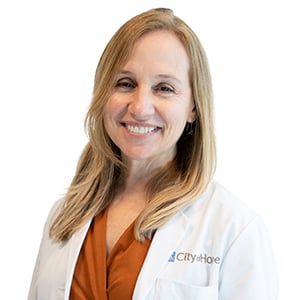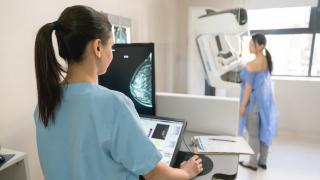As the newly appointed chief of the Division of Breast Surgery in the Department of Surgery, Veronica Jones, M.D., City of Hope continues to seek out the latest advancements and look to the future in order to provide the most innovative treatments for patients with breast cancer. From clinical trials of novel immunotherapies for breast cancer that has spread to the best surgical options to help reconstruct the look and feel of a breast, City of Hope doctors and surgeons are providing leading-edge treatments that optimize survival and quality of life.

“The idea that breast cancer is an automatic death sentence is false. It’s a myth,” said Jones, also an assistant professor. “We can manage a lot of breast cancers and extend life. And a lot of breast cancers are curable.”
“We are getting more and more precise with our surgeries, which includes robotic mastectomies and ablative procedures,” she continued. “We are also combining advances from precision medicine and novel imaging technologies with surgery in order to minimize potential complications and side effects.”
With advances in genetic assessment making treatment plans more tailored to the individual patient than ever before, that same personalized mindset should be applied to prevention, Jones said. The most important thing, she says, is to discuss your individual risk factors with your doctor and to receive breast cancer screenings, such as mammograms and/or magnetic resonance imaging, accordingly. “Screening recommendations vary. It’s not a one-size-fits-all for treatment or screening. The best piece of advice is for each patient to have a detailed discussion with their physician about their personal risk. You have to know what your risk is and find your comfort level for screening — it has to be individualized.”
Read on for the latest innovations in breast cancer treatment.
CAR T Cell Therapy for Breast Cancer
City of Hope doctors are leading a clinical trial that uses a type of immunotherapy — chimeric antigen receptor (CAR) T cell therapy — that was developed on-site to treat patients with HER2-positive breast cancer that has spread to the brain. Jana Portnow, M.D., a professor in the Department of Medical Oncology & Therapeutics Research and co-director of the Brain Tumor Program, is leading the Phase 1 trial.
For this trial, patients’ T cells are collected and then reengineered in a City of Hope laboratory to actively seek out and destroy cancerous cells. More specifically, the T cells are genetically engineered to express a CAR that allows these immune cells to target and eradicate HER2-positive cancer cells.

“What we are trying to do is to train the immune system to kill cancer,” Portnow said. “Cancer cells figure out a way to hide from the immune system. As others have said, T cells are the ‘soldiers’ that are able to kill cancer cells.”
Portnow added that funding is available for patients to travel to City of Hope and hotel stays. Patients will need to stay at or near City of Hope for about six weeks to participate in the trial.
Other immunotherapy trials taking place at City of Hope include a Phase 1, first-in-human trial to study the effectiveness of blood cells that have been engineered to contain an anti-HER2 CAR in patients with HER2-overexpressing solid tumors. To join the trial, patients must have HER2-positive recurrent or metastatic solid tumors for which no treatment options are available.
Another Phase 1/2 trial is studying the use of CAR T cells for metastatic breast cancer patients. Both trials are being led by Joanne Mortimer, M.D., director, City of Hope Women's Cancers Program, co-leader of the breast cancer program and the Baum Family Professor in Women’s Cancers.
More Realistic Nipple Tattoos
Mastectomy (surgical removal of one or both breasts) is a common and effective procedure for breast cancer patients, but it can also negatively impact a woman’s body image. The procedure often involves the removal of the nipple and areola, which can dramatically change the appearance of the breast. To help mastectomy patients rebuild their self-confidence and improve their self-image, City of Hope offers advanced surgical techniques that help reconstruct the look and feel of the breast.

For patients who have had their nipple and areola removed during a mastectomy, City of Hope plastic surgeons are now offering 3D nipple areolar complex tattooing, a reconstructive procedure that restores a more natural appearance to the area. While 3D nipple areolar tattoos are not actually three-dimensional, this innovative surgical technique uses multiple shades of nontoxic ink, as well as expert techniques founded on an understanding of skin tone, shadows and highlights, to create a more realistic appearance to the nipple and areola.
Previous nipple-tattooing methods typically used only one or two colors to create concentric circles on the breast after nipple reconstruction. 3D nipple tattoos appear more authentic and do not require an additional reconstructive surgical procedure.
“A few years ago, some really smart tattoo artists designed tattoos of the nipple that make it look three dimensional. So that means no surgery, but literally a tattoo — but a complex tattoo to give you the illusion that there's something there,” explained Wai-Yee Li, M.D., Ph.D., an associate clinical professor in City of Hope’s Division of Plastic Surgery.
Improved Breast Cancer Surgical Techniques
For mastectomy patients who are not candidates for implants following radiation, Li also specializes in latissimus dorsi flap reconstruction. For this procedure, a section of skin, fat and muscle is taken from the patient’s back and pulled forward to form a reconstructed breast. Because no blood vessels are divided using this method (as opposed to another popular procedure that involves removing abdominal fat and transplanting it into the chest cavity), risks are lower, side effects fewer and recovery time faster.
“The latissimus dorsi flap was very popular during the 1970s and even through to the ‘80s, but with the advent of improving the microscopes used to operate, free tissue transfer became more popular. Free tissue transfer is where you take tissue from the abdomen, you cut the blood vessels and then you reconnect them to the chest wall vessels. That has been a way more popular way to do breast reconstruction than the latissimus flap,” said Li.
The benefit of the latissimus flap procedure, in contrast, is that instead of cutting the blood vessel, it is simply moved into place. This means there is less chance that blood supply will be lost, which could lead to tissue death, Li explained.
In addition to resurrecting the latissimus flap and perfecting the procedure, Li is also performing clinical research focusing on refining the surgery’s post-op pain management protocol. By using a long-acting local anesthesia that blocks the nerves in the front and back of the chest, patients are able to go home after latissimus flap surgery in just one day.
A Shot to Replace Chemotherapy
For patients with metastatic HER2-positive breast cancer, a combination of Herceptin and Perjeta (two immune targeted therapy drugs) is a first-line treatment. Administered by IV alongside chemotherapy, this drug combination is quite effective, but the process is time consuming, and can last up to 2.5 hours.

In 2020, the Food and Drug Administration approved Phesgo, a new drug that offers faster administration of Herceptin and Perjeta, and City of Hope is now offering this drug to patients who qualify. Phesgo is given by subcutaneous injection and the first dose takes only eight minutes to administer. Subsequent maintenance injections take only five minutes.
Jennifer Pio is a patient who uses Phego in place of the traditional Herceptin/Perjeta infusion and has nothing but positive things to say. “My normal infusion was roughly an hour and a half, and the shot only takes five minutes,” she says. “I love the time savings in the chair and how quickly I am in and out of the infusion room for my visit. An added bonus for me was being able to have my port removed, which was a constant daily reminder of my diagnosis and super uncomfortable.”
Breast Cancer Treatments: Looking Forward
Jones is excited about the new surgical techniques and treatment options, as well as what she sees on the horizon when she envisions the future of City of Hope’s breast cancer program. “We are bringing integrative oncology to the breast cancer space to address side effects and minimize discomfort,” she said. “We’re bringing new, more precise imaging technologies into our practices. We are making waves in global oncology to enhance breast cancer care around the world — we’re expanding not just with our new sites in Atlanta, Phoenix and Chicago, but internationally as well. We’re taking on health care disparities with more and more research, such as my study looking at how different genes may create disparate outcomes in Black and white breast cancer patients. I'm passionate about studying responses to therapies and how that varies across different people groups. There will be lots of focus on innovation and health equity going forward. Innovation, equity and quality of life — that’s what we’re going after.”
Still, it is the bond with her patients that resonates most.
“That connection with patients, knowing that we're in this together, that they want us to find breakthroughs as much as we want to find breakthroughs, and seeing them, talking to them,” she says. “Just knowing that I'm not going at this alone and there are people who really need me to keep driving forward, inspires me. I have great relationships with my patients. Seeing them is what keeps me going.”
